CRAFTING THE PRESENT
Børge Mogensen, Hans J. Wegner, Nanna Ditzel, Kaare Klint, Jasper Morrison, Barber Osgerby, Cecilie Manz, Hugo Passos, Maria Bruun, Space Copenhagen, Jørgen Gammelgaard, Poul M. Volther, Hannes Wettstein, Keiji Takeuchi, Damian Williamson, Erik Jørgensen, Erik Jørgensen Studio, Monica Förster, Erik Ole Jørgensen, Hans Sandgren Jakobsen, GamFratesi, Foersom & Hiort-Lorenzen, Jens Risom, OEO Studio, Welling / Ludvik, Due & Trampedach, Sofie Østerby, Thau & Kallio, Arde, Ernst & Jensen, Shin Azumi.













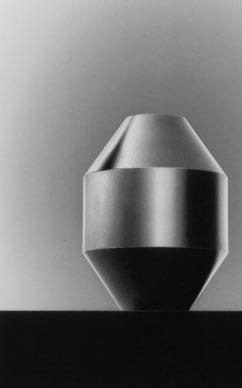

INDEX INTRODUCTION Words by Rasmus Graversen 02 HONOURING A HISTORY OF PURPOSEFUL DESIGN Fredericia’s legacy 04 HANS J. WEGNER An explorative designer 11 WEGNER OX CHAIR Strikingly bold 12 CRAFTING IN THE PRESENT An upholsterer’s perspective 19 BØRGE MOGENSEN A pioneering designer 30 THE SPANISH CHAIR Iconic modernity 32 2204 WING CHAIR Upholstered timelessness 44 BUILDING UPON HERITAGE A designer’s perspective with Maria Bruun 56
Words by RASMUS GRAVERSEN, CEO and 3rd generation of the family behind Fredericia
Furniture connects us to the present. Furniture is helplessly analogue. Good design allows people to engage with each other, sense the quality of materials, and create a stimulating visual environment that gives a place spirit. As Wegner said, “A piece of furniture first becomes truly complete when someone sits in it.”
At Fredericia, we are privileged with a legacy of iconic designs but also a legacy of craft and an appetite for innovation and collaboration. A tradition formed by techniques, tools, materials, and, most importantly, people. It is a culture of design that can only thrive when it is being put into use, nudged, and sometimes transformed.
This publication is dedicated to celebrating the craft and community that inform our culture of design in this present-day and time.
02
INTRODUCTION

HONOURING A HISTORY OF PURPOSEFUL DESIGN
Since our establishment in 1911, Fredericia has cultivated a proud tradition of exquisite craftsmanship, innovative design and design thinking. Emerging from the origins of Danish furniture design, Fredericia’s rich heritage embodies an exceptional design archive. Showcasing undeniable classics, a profound understanding of furniture, and a commitment to craftsmanship passed down through generations.
Our proud spirit originates from the founding workshop, established on the principles of traditional craftsmanship and modern industrial production. Initially named Fredericia Stolefabrik (Fredericia Chair Factory) in the city of its namesake, it swiftly became renowned for crafting furniture of exceptionally high quality.
In 1955, visionary entrepreneur Andreas Graversen blended the legacy of exquisite furniture with modernist ideals. A close collaboration was born with Børge Mogensen, Fredericia’s first in-house designer.
Mogensen’s intuitive understanding of materials and an acute sense of proportions resulted in a collection of iconic pieces. They are still revered today by collectors, museums, architects, and designers worldwide.
Since Mogensen’s era, Fredericia has continually evolved. Over time, the Graversen family has expanded Fredericia’s roster of designers from Ditzel, Klint, and Wegner to contemporaries such as Barber Osgerby, Jasper Morrison, Cecilie Manz, Maria Bruun, Hugo Passos, and Keiji Takeuchi. Together, they cultivate a creative culture marked by design integrity, artistic expression, material expertise, and industry acumen, fostering the rejuvenation and reinterpretation of Fredericia’s design ethos. This ethos embraces the virtues of patience and the relentless pursuit of excellence.

04
TWO FRIENDS. Pictured right, Andreas Graversen with Børge Mogensen, 1969.
The Mogensen 3236 Chair was Børge Mogensen’s first design for Fredericia in 1956.
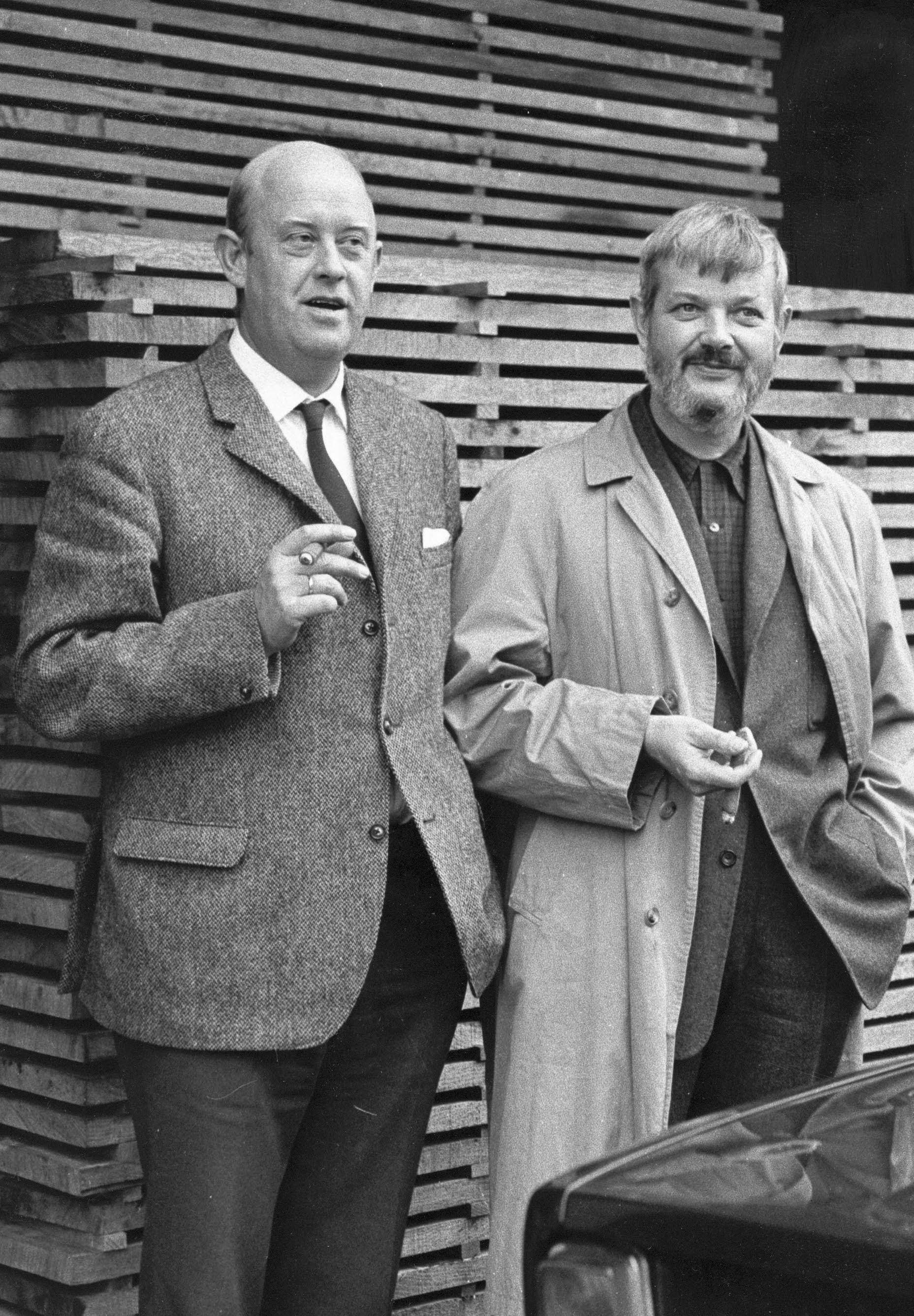

06
FREDERICIA. Andreas Graversen’s house in Fredericia, 1964, designed by Børge Mogensen and Arne Karlsen.

A BØRGE MOGENSEN LIVING
ROOM.
07
Graversen’s house was furnished with Børge Mogensen’s furniture, including the Spanish Chair, BM375 Nesting Tables, Spanish Dining Chairs and the 2213 Sofa.

MASTERS IN THE MAKING. Two of Fredericia’s prominent designers, Mogensen (middle) and Wegner (left) were classmates at the School of Arts and Crafts, which became the beginning of a lifelong friendship.
08

09
AT HOME. The Spanish Chair in Børge Mogensen’s own house in Gentofte, Denmark, next to a sculpture by the Danish artist and friend Svend Wiig Hansen.

HANS J. WEGNER
One of the most prolific Danish talents of his era, Hans J. Wegner (1914–2007), is celebrated for infusing functional designs with a poetic, playful touch, which made him pivotal in propelling Danish Modernism to international acclaim.
Throughout his career as a designer, Wegner earned a reputation for challenging the conventions of traditional furniture design. He sought to infuse imagination while catering to human contours and movements, viewing furniture as a meticulously crafted work of art. Wegner’s style seamlessly merges gentle forms with a steadfast commitment to functionality. Recognising a chair’s intimate interaction with the human body, he excelled in ensuring ergonomic comfort.
11
Wegner Ox Chair
12 STRIKINGLY BOLD
1960
Designed by Hans J. Wegner,


When The Ox Chair was first introduced in 1960, it presented a strikingly bold and confident design, standing in contrast to the understated approach of Scandinavian furniture.
Referencing ox horns, a voluminous body, and a delicate frame, the sculptural chair exemplifies Wegner’s profoundly organic and artistic approach to furniture design, expressing his ambition to redefine traditional norms. Within Wegner’s extensive portfolio, the iconic Ox Chair is hailed as one of his ultimate masterpieces.
With its distinctive contours, refined craftsmanship and groundbreaking complex upholstery, The Ox Chair is arguably Wegner’s most remarkable design. It is daring and creative while also serving as an analysis of body postures, inviting various seating options. Wegner furnished his own living room with The Ox Chair, considering it a personal favourite.

14
PRESENT DAY. The Ox Chair in Leather Max 91 Nutshell.
Wegner showcasing The Ox Chair.


15
THE FAVOURITE. The Ox Chair in Hans J. Wegner’s own living room, photographed in 1994.

INTRODUCING. Ox and Queen chairs on display in 1960 at the furniture fair in Fredericia, Denmark.
16
PATINA. Pictured right, a patinated Ox Chair in Leather Max 95 Cognac.


CRAFTING IN THE PRESENT
With ERIK WICHMANN, Fredericia upholsterer
Our upholstery workshop in Svendborg, Denmark, represent a combined body of upholstery knowledge unapparelled in Scandinavia, where we keep our traditions alive and apply our internal wealth of knowledge.
Hans J. Wegner’s Ox Chair is a perfect example of an innovative approach to an old craft. With its voluminous upper body on a delicate steel base, it was a challenge to produce when it was first launched in 1960 by the AP Workshop in Copenhagen. In the late 1980s, Wegner turned to Erik Jørgensen for his upholstery expertise, and the result was quite cutting-edge at the time. Together, they introduced modern block foam to the chair, making it highly stable in form over time, as opposed to the traditional method used before. When Fredericia acquired Erik Jørgensen’s company in 2020, the workshop, upholsterers and knowledge were kept to maintain the expertise and high production standard.
UPHOLSTERY
19
KNOWLEDGE. Pictured left, a patinated Ox Chair in Leather Max 95 Cognac.
– AN UPHOLSTERER’S PERSPECTIVE
The process of upholstering the Ox Chair remains a very handcrafted technique and is a demanding task. The sculpted lines and organic curves require unique expert craftsmanship skills and a certain amount of physical strength. Training a new upholsterer for this chair takes 1.5 years due to its complexity. When trained, it takes an entire day and a half to handcraft a single Ox Chair.
Our upholsterer, Erik Wichmann, brought his unique skills from Erik Jørgensen to Fredericia and has spent years of his professional life creating many of the complex Ox Chairs that adorn homes worldwide. Here, he discusses his craft and what it takes to create a chair like this.
“Upholstering begins with raw materials that, at first glance, seem insignificant. Yet, through a process likened to a battle, one ultimately arrives at a finished product. This transformation from nothing to something is what I find so appealing about the craft.
MOVEMENT
Attention to detail is paramount in upholstering. We must adhere to countless small techniques and adjustments. The craft involves standing, breathing correctly, and employing precise movements to pull and push materials. Every seemingly negligible touch matters, and there’s a reason for each step, much like the small foam pieces we meticulously place.
MUSCLES
The physical demands of the job are considerable. Those who do this daily have developed techniques to minimise the strain on our bodies. Rather than relying solely on our hands, we’ve learned to use our body weight to push and pull in different places, finding ways to ease the workload. It’s a matter of knowing your way around it.
The Ox Chair is highly complex to make both in terms of internal upholstery and the external process, where perhaps only Wegner’s other iconic chair, the Papa Bear Chair, can be compared. Both chairs have many parts that need to be upholstered and assembled. We need to feel our way around this chair from all angles.
HANDCRAFTED. Pictured right, Wichmann in the upholstering process in Svendborg, Denmark.
20

FEELING
When we upholster, we constantly listen, look, and feel. Cutting leather for different chair parts, such as an armrest, involves creating solutions for how the material will stretch and move. If you pull too hard, you risk damaging the leather.
Fabric and leather behave differently. Fabric is more straightforward, with fewer directional constraints. Leather, however, requires careful handling. It might be thin in some areas and stiff in others, necessitating a nuanced approach. The balance of the leather and the upholsterer’s intuition are crucial.
Although we often work on the same types of furniture repeatedly, every piece of leather or fabric is unique. This variability means each presents unique challenges, even when making two similar pieces.
LISTENING
I have a specific delicate spot between the seat and the arm where I put my ear to listen the most. Listening to the leather is part of the process. Just before it starts to tear, you can hear a slight crackling. This sound guides us, ensuring we stay within the material. It is good when you hear it crunch a little because it means it will last and has strength.
UNDERSTANDING
Upholstering involves more than following a set procedure— this chair has no recipe. It’s about understanding the material and making adjustments as needed. For instance, when working on the neck of a chair, if you encounter a bulge, you must know how to manipulate it to achieve a smooth finish.
Each piece of furniture has complexities, like the Cera leather, requiring significant strength and precise handling. The leather must be warmed and meticulously shaped to achieve the desired result. Working with leather is particularly challenging because it varies in thickness and flexibility. The balance and uniformity of the material are critical. For example, the armrest must feel consistent, whether you run your hand over the front or the back.
22
DETAILS. Pictured right, a patinated Ox Chair in Leather Max 95 Cognac.


Even though I craft this chair every day, every chair is different. Textiles vary, and no two pieces of leather are the same, even if they may come from the same hide. At this very moment, I am about to craft two chairs from the same textile, and the challenge is making them look alike, though they will always be different.
COLLABORATING
Upholstering is a collaborative effort. We share techniques and insights, ensuring consistency in our work. Over time, we’ve developed standards based on original designs that guide our process. This shared knowledge, handed down through the decades, ensures that, despite individual differences, our work maintains a unified quality. When you start apprenticing as an upholsterer working with Ox Chair, there is no written guide to follow; you observe, ask, sense, and take your time to get to know this complex piece of furniture.
SIGNATURE
Each piece carries the signature of its maker. By simply touching a piece, we can often tell who upholstered it. This personal touch is evident in the finished product. You put your nature into the way you upholster.
We are four people crafting the Ox Chair at the Fredericia workshop, and only we can detect these very subtle differences in how we cover it. Others will not notice them with the naked eye and will see only similar chairs.
Our traditional methods of building furniture are evident in every piece we create, reminiscent of those made in our grandparents’ time. The attention to detail and commitment to quality remain unchanged, ensuring each piece is crafted to the highest standard. It is the chair of details.”
EVERY CHAIR IS DIFFERENT. Pictured left, the workshop in Svendborg, Denmark.
25

26
HORN. The moulded foam of an Ox Chair horn from the production in Svendborg, Denmark.

TOOL. Custom-made tool made especially for upholstering an Ox Chair. Used to remove staples in tight places.
27










CRAFTING THE WEGNER OX CHAIR, SVENDBORG, DENMARK. The process of upholstering the Ox Chair remains a very handcrafted technique and is a demanding task. The sculpted lines and organic curves require unique expert craftsmanship skills and a certain amount of physical strength. Training a new upholsterer for this chair takes 1.5 years due to its complexity. When trained, it takes an entire day and a half to handcraft a single Ox Chair.
28

Renowned as the founding designer of Fredericia, Børge Mogensen (1914–1972) is acclaimed for his pioneering role in shaping Danish Modernism. His enduring legacy reflects a lifelong ambition to create furniture that is both functional and beautiful, designed to last for generations.
Throughout his career as a designer, Mogensen found inspiration from around the world, dedicating himself to creating everyday furniture that transcended mere functionality. His aim was to craft enduring pieces that would enrich people’s lives. Mogensen’s unparalleled ability to create iconic furniture, with its use of natural materials and timeless expression, allows it to remain relevant across various times, generations, and cultures.
30
BØRGE MOGENSEN

The Spanish Chair
32
ICONIC MODERNITY
1958
Designed by Børge Mogensen,


The Spanish Chair stands out as one of Mogensen’s most celebrated designs and a personal favourite, showcasing his unique take on modernity. Created for Fredericia in 1958, the inspiration behind this extraordinary design stemmed from a family trip to Andalucia, where he experienced the Spanish medieval style of furniture construction.
Featuring signature wide armrests and clean lines, the Spanish Chair boasts a striking aesthetic. It is expertly crafted from solid oak or walnut with geometrical precision. The rustic combination of saddle leather, a wood frame, and metal buckles adds character, developing a unique patina that becomes even more stunning over time.
The high-premium semi-aniline leather is crafted by skilled artisans at the esteemed Tärnsjö Tannery in Sweden. For over 60 years, they have tailored pieces for Mogensen’s Spanish Collection. As the leather expands over time, the adjustable straps can be tightened, ensuring a comfortable seating experience from day one and for the rest of your life.

34
COUNTRY HOUSE. Pictured above, the first showing of The Spanish Chair at the Copenhagen Cabinetmakers’ Guild Exhibition “Country House”, 1958. PATINA. Pictured right, detail of a patinated Spanish Chair with Natural Saddle leather.
The Spanish Chair at the Copenhagen Cabinetmakers’ Guild Exhibition “Country House”, 1958.


THE SPANISH CHAIR. Original drawings of The Spanish Chair, July 1958.
36

37



40
DARK BROWN. Pictured right, The Spanish Chair in Walnut and Dark brown saddle leather.
TESTING. Archive picture from the 1970s.


42






CRAFTING SADDLE LEATHER FOR THE SPANISH CHAIR AT TÄRNSJÖ TANNERY, SWEDEN. For over 60 years, Tärnsjö Tannery have tailored pieces for Mogensen’s Spanish Collection.





ASSEMBLY AND FINISHING TOUCHES IN FREDERICIA, DENMARK. The Spanish Chair is expertly crafted from solid oak or walnut with geometrical precision.
43
Designed
by
Børge Mogensen,
2204 Wing Chair
44
TIMELESSNESS
UPHOLSTERED
1963



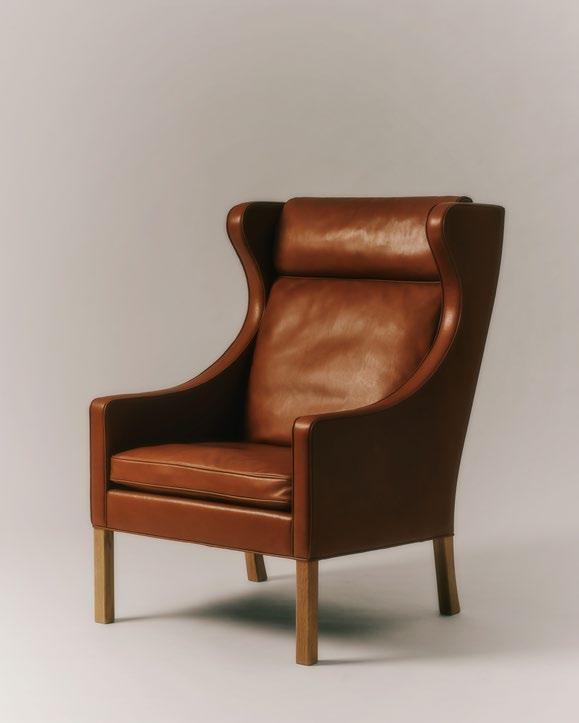
The Mogensen 22 Collection is a classic and timeless series of fully upholstered sofas and lounge chairs, characterised by sharp outer contours and soft cushions within – an expression that combines enduring form with a sublime level of material quality, upholstery precision, and ultimate comfort.
The first iconic sofa in this collection was released in 1962, followed by many variations, evolving into Danish design institutions. The Mogensen 2204 Wing Chair from 1963 is regarded as one of the most comfortable pieces of furniture Mogensen ever created. Its soft leather embraces the body, and its winged design helps shut out the world, providing a peaceful space for reading or relaxing.
On closer inspection, the chair reveals delicate craftsmanship in its piping, solid wood legs, jute webbing, and down pillows, all supported by a solid hardwood frame. A signature material in Mogensen’s designs is bull hide, which is less elastic and provides the sturdy support needed to maintain the shape of a Mogensen sofa for generations. This is a strength test for the upholsterer but was a must for Mogensen.
47
TOOLS. Pictured left, hammers used for the piping on the 22 series in the production in Svendborg, Denmark.
MATERIALISED ICON. Leather hides and 2204 Wing Chair in Leather Cera Russet brown.

48
TOOL. A custom-made hammer used in upholstery when textile and leather covers need adjusting into place without leaving marks on the surface.

49
INSIDE. The end gable used for the wooden frame of the 2204 Wing Chair before upholstery.




53
WING CHAIR. Original drawing of the Wing Chair, 1964.
UPHOLSTERY. Pictured left, cutting textile covers in Svendborg, Denmark.
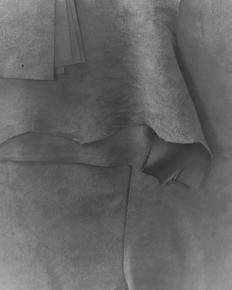









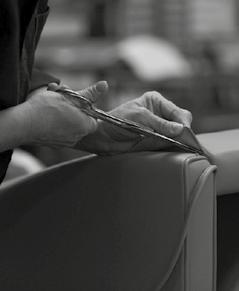


CRAFTING OF THE 22 SERIES IN SVENDBORG, DENMARK.
54
The 2204 Wing Chair reveals delicate craftsmanship in its piping, bent solid wood legs, jute webbing, and down pillows, all supported by a solid hardwood frame.

55
BUILDING UPON HERITAGE
With great respect for Danish design history and based on this heritage, Danish designer Maria Bruun creates furniture and objects with an uncompromising approach to the subjective and the artistic. Her preference for wood and its impact on us as humans contributes to transforming creative visions into sculptural and tactile furniture that you feel compelled to admire and use.
For Bruun, creation is a highly intuitive and subjective process. She often designs outside of a brief to avoid restrictions or limiting frameworks, allowing ideas, forms, and materials to flow freely and transform with the project. Her curiosity and respect for form and design are evident in her always thoughtful and sculptural solutions, as seen in the poetic Islets and Pioneer collections.
Bruun believes that there is an essential value in translating artistic visitation into relatable and assessable designs. She also believes that we must balance past and present, as well as traditional craftsmanship and modern industrial design. On the theme of craft, tradition and innovation, she unfolds:
“In the world of design, the tension between innovation and tradition is ever-present. It’s a conversation that continually evolves, reflecting the changing needs and tastes of society. One day, oak surfaces might be revered for their timeless ele-
56
PERSPECTIVE
– A DESIGNER’S
With MARIA BRUUN, Fredericia designer

57
INTUITIVE DESIGN. Maria Bruun in her studio in Copenhagen with Islets Dining Table and Pioneer Stools.
gance; the next, they could be replaced by sleek, modern aluminium, seen as the pinnacle of contemporary aesthetics. The question arises: How do we honour the past while embracing the future?
When collaborating with their designers, Fredericia remains curious and respectful – even when they eschew conventional brand history. The new generation refuses to let past practices shape their new work, and is unafraid to stray away from traditional influences and previous designs to forge a unique path. They will not let tradition dictate their creations. I find this tendency and way of thinking exciting. This radical approach will bring fresh perspectives and innovative designs, proving that sometimes, stepping away from the past can lead to extraordinary results both in the present and in the future.
However, past designs do inform the new. The next generation of designers brings something new, but they also need to understand traditional craft. The classics of the past are still relevant, and we must not camouflage when they were made but instead pay tribute to that time and the designer. There’s undeniable value in looking back. Many of Thomas Graversen’s early designs in the 1990s were informed by the classics— pieces that, despite being decades old, remain relevant and exciting today.
58



These designs serve as a testament to the enduring quality and appeal of well-crafted items. Incorporating such timeless elements into new creations can yield products that resonate across generations, blending old-world craftsmanship with modern functionality.
The old icons take the new ones by the hand and validate them, while the new icons bring the old ones into the present and future. There is a synergy between the two, which Fredericia balances with, both archival respect and innovative spirit.
I have learned a great deal working closely with Fredericia and being introduced to their extensive knowledge base, which we can draw upon. Some places focus solely on automated production, but here, the process is the priority. Time is taken to find the best solutions through direct dialogue between designers and decision-makers, ensuring that ideas are effectively realised. When we go into production, everything has to be tight, but until then, we can experiment.”
59
Bruun working on the design of the Pioneer Stool in her studio.

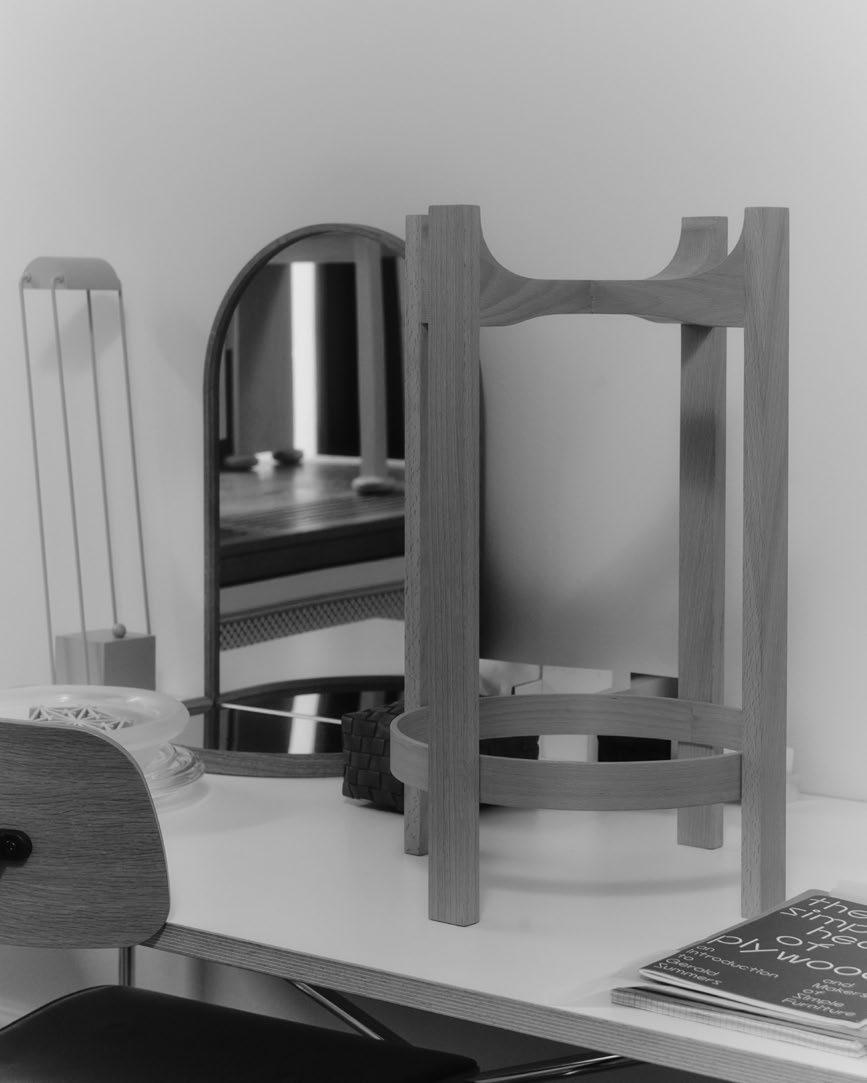
61
BEGINNINGS. Pioneer base prototype at Maria Bruun’s studio.
MODERN FUNCTIONALITY. Pictured left, Pioneer Stool.

62
THE OLD WITH THE NEW. Maria Bruun’s Islets Dining Table with Børge Mogensen’s first design for Fredericia, The Mogensen 3236 Chair.
STACKED. Pictured right, Pioneer Stools.

PICTURE CREDITS
Maria Bruun, Anne Bråtveit, Emil Christensen, Fredericia, Jens Frederiksen, Elizabeth Heltoft, Jesper Høm, Stig T. Karlsson, Mogens S. Koch, Peter Vinther.
Every reasonable attempt has been made to identify owners of copyright. This has not been possible in all cases. We apologise for any omissions.
GRAPHIC DESIGN
Fredericia / Amalie Alexandra Hasgard
TEXT
Maria Bruun
Fredericia / Theresa Bødkergaard Rasmus Graversen
PRINT RUN
2000
Printed in Denmark 2024
CONTACT
Headquarter
Fredericia Furniture A/S Treldevej 183 7000 Fredericia
Denmark +45 7592 3344
info@fredericia.com @fredericiafurniture fredericia.com
SHOWROOMS
Copenhagen Løvstræde 1, 4th & 5th floor 1152 Copenhagen
London 1 Dufferin Street London EC1Y 8NA
Oslo Drammensveien 120 N-0277 Oslo
64 CRAFTING THE PRESENT















fredericia.com




















































































































